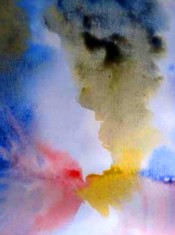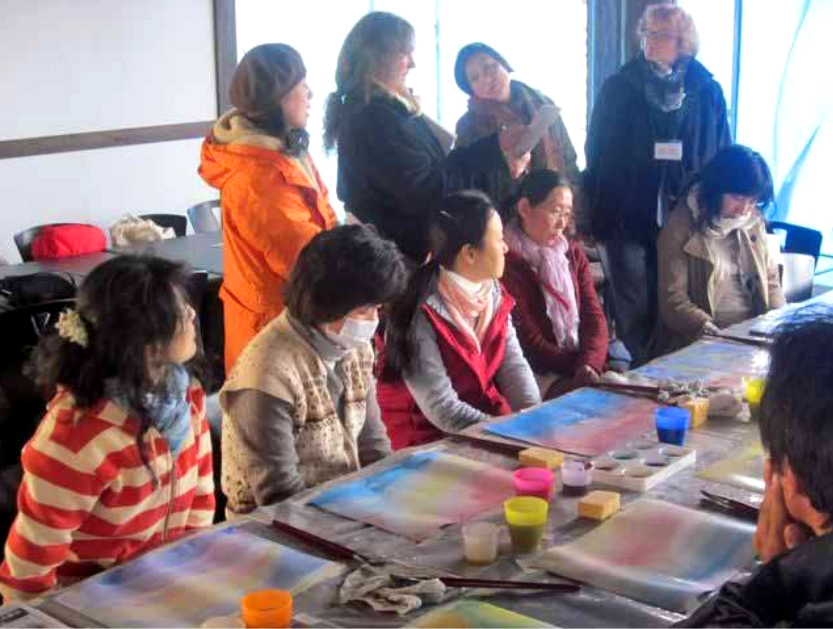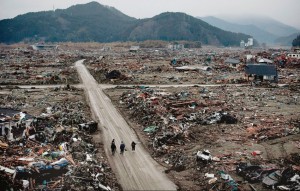Waldorf News
Emergency Pedagogy in Japan

By SUSIE GAY, Titirangi, New Zealand
In April 2011, Susie Gay, art teacher and art therapist at Titirangi Rudolf Steiner School near Auckland, New Zealand and counsellor in private practice, joined an emergency relief team of Steiner teachers, therapists and a doctor, organised by Karlsruhe-based The Friends of Waldorf Education, to offer support to post-earthquake and tsunami-devastated Japan. Here Susie shares some impressions and experiences working with ‘emergency pedagogy’ with both children and adults. Susie is now a class teacher at TRSS
I joined the team of relief workers in Tokyo and we began our intensive two-weeks’ work with both children and adults, many of whom had lost family as well as all of their possessions through the extensive earthquake and tsunami damage in March 2011.
It was our task to go to the vicinity of the north-east region of Japan located near the epicentre of one of the world’s largest earthquakes. This had sent a devastating tsunami down three hundred kilometres of the coastline which in some places had reached up to forty feet above sea-level as well as reaching up to forty kilometres inland. The prefectures of Sendai, Miyagi, Iwate and Fukushima were particularly hard hit.
We immediately set off on a long bus journey, along with our emergency helmets, boots, masks and a Geiger-counter to measure the vagrant radiation leaking from the Fukushima Nuclear Power Plant. The bus views on this northern route gave little away of the enormity of the recent disaster. Everything seemed normal. It was when we came into the vicinity of Fukushima that quietness descended on the bus. However, our Geiger-counter revealed no significant changes but, when we stopped for a rest, it was noticeable—the air had an acrid smell; it was not a welcoming place to rest any longer than necessary and we were still eighty kilometres away from the stricken power plant at Fukushima.
Our accommodation was a large communal guesthouse in Osato, situated in peaceful rolling hills, out of tsunami reach, near the town of Shichigahama. On the second day, we were greeted with a good shaking of yet another aftershock—a reminder that the aftershocks would continue at the behest of the power behind nature and no place was immune. We shared our accommodation with local farm workers and were joined by a team of fellow Japanese teachers, therapists and eurythmists, as well as some psychologists, doctors and a logistics person, who worked with us as a support group. They acted as translators, conducted meetings with the local authorities and health officials and, along with this extensive preparation, they provided and prepared our food and drove the mini buses. What a wonderful team they were—they worked with full dedication and brought optimism and warmth to all. They even instructed us in Japanese daily cultural traditions of ceremony in ‘greeting’ and in the evening ‘hot-bath’ ritual. We gradually accustomed ourselves to eating the daily diet of rice and accompanying accoutrements. The group also introduced us to Shinto and Buddhist temples; these peaceful, still places were a relief to experience after a hard day’s work. Many of our companions also had a great sense of humour, which was necessary on occasions!
Each day began in a large circle and Rudolf Steiner’s verse ‘The Motto of the Social Ethic’ was spoken in both German and Japanese. How wonderful that was to experience! Then we acknowledged each other further with ‘Hallelujah’ in eurythmy and each group of people we were to work with experienced ‘Hallelujah’ as well as a reverential and moving Japanese verse giving us strength for the daily tasks ahead.
The first group we worked with was the Steiner ‘Saturday’ Niji no Mori school group of children and parents. This group were very still and showed signs of shock. The team’s approach was to work with activities as experienced in the ‘morning circle’; where movement is paramount. The group soon warmed and gradually, as we passed each other in a winding spiral, eyes met and acknowledgement arose. When the games began, so did the smiles. We completed this ‘meeting’ with a beautiful and reverential verse in eurythmy in Japanese. Afterwards, therapy workshops took place. I found myself working with about 30 adults and children of all ages in a painting workshop. The time was too short. But how deeply involved everyone was—silent, living into a deep out-breathing through watercolour.
We had many further group meetings with circle work, where rhythm and movement helped stimulate people again to re-find an inner harmony. This was considered a necessary step for each person to go through after the initial shock. The Team Leader, Bernd Ruf, took this direction due to his extensive research and experience with post-traumatic shock experience in Lebanon (2007), China (2008), Gaza (2009), Indonesia (2009), Haiti (2010), Gaza (2010), Kyrgyzstan (2010). Bernd Ruf was an inspiring and well-informed leader of this expedition who gave many in-depth talks about working with the different stages experienced by both children and adults with psychological trauma. He is the author of When the World Collapses: Emergency pedagogical interventions for psychologically traumatised children in crisis regions and has proposed setting up trainings for ‘emergency pedagogical interventions,’ including other therapeutic interventions.
The therapy took the form of pedagogical–therapeutic activity as an initial step in allowing the rhythmical system to be stimulated to enliven self-healing. Different groups of people in various locations gained a new-found freedom in being able to move together; and this helped them to gradually lift out from the paralysing, stultifying effects of shock. Artistic workshops followed as activities, whereby expression through painting or form-drawing work could help to release paralysed feelings. Both adults and children could experience the same ‘morning circle,’ games and artistic activities. After one of our therapeutic interventions and towards the end of a deep session in art therapy, one of the participants rose up with tears in her eyes; I had to wait to behold the moment. She then spoke out: that she had not ventured out of her house since that disastrous day and now she knew why it had to be now. “Before today I only experienced grey, but now for the first time since after the tsunami I can see and experience colour again,” she said. This was a moving moment.
Prior to seeing the physical devastation of the earthquake and tsunami damage, we experienced its effects through the initial meeting of the people who came to us. It was, however, a chilling experience to drive through the remains of the trail the ‘monster’ had left behind in the tsunami-ravaged landscapes. We undertook a few bus journeys, which drove home the calamity that had struck Japan. But it was when we went to Onagawa that we saw how the tsunami had ripped out 90 percent of the once peaceful, coastal fishing port. We drove along a newly hewn-out road, which wound through rubble, hollowed out four-storey buildings; where we saw boats and cars crushed and crumpled together like grotesque sculptures marking the way the wave struck. There were cars on top of high buildings and trains on hillsides lodged in strange positions, as well as the tattered remains of the households strewn across the countryside.

We slowly climbed the hill to where the hospital had stood and then further up to where the junior school and present ‘refuge’ camp were located. I was surprised to see crumpled cars high up on the hillside road. It was only when I heard that the tsunami had wiped out the first floor of the hospital taking away patients and staff that I realised exactly how high it had reached. It had even lapped outside the entrance area of the school. This wave had been forty feet high! Luckily, most of the children and their teachers had been in school when it came. But not so lucky were many parents who had not been able to reach safety in time.
When we climbed out of the bus, I could once again smell the acrid smell, which reminded me of Fukushima. Nearly everyone wore masks. We then saw the huge emergency operation taking place in and around the school. Here there were loads of goods arriving—emergency packaging, everyday necessities, with bottled water being of prime importance. We heard how the teachers and children had been marooned on their island for three days, with only water to drink, in very cold weather with snow on the surrounding hills. They all had to wait to be rescued.
The teachers and therapists there had worked hard to bring back warmth, comfort and hope to the children. Many of the children were based in the large building day and night and many of the teachers still slept there to be of support. They were warm and gracious to us and we soon felt the supportive atmosphere they had built around the classes as they carefully guided the children through their post-trauma experiences. There were also active educational psychologists there.
I worked with classes one and three as a teacher and art therapist, providing pedagogical-therapeutic interventions. I found most of the children able to participate in listening to the Japanese fairy stories I told, which were in turn translated into Japanese, also in the ‘morning circle’ and in the following art lesson. The children were very responsive and enjoyed working with the New Zealand honey beeswax candles which I had brought as a gift, but there were some, however, who showed signs of deep inner disturbance. Their teachers were warmly encouraging but I found I had to observe very carefully those who needed to be acknowledged with extra attention and singular careful intervention. Many of the children showed signs of slight excarnation and a kind of transparency unusual to see in young children. They were all very sensitive as to how the activities were given.
Out of twenty-five class one children, about five drew pictures of the tsunami rather than the well-known fairy story of Momotaro, which I had told. For these five children, it was important that they could express their, still living, tsunami experience through colour as a way to help purge the event still in them. The others could take the hero of the fairy story and live into the imagination, which reflected the courage of a little fellow who had to go and fight the wicked trolls over the sea and bring back the treasure. The powerful healing effect of the ‘old’ fairytales, which hold great wisdom, could be seen directly through the shining faces of the rest of the children. They also received a first form-drawing lesson, in order to experience the value of the upright and the curve.
 Working with class three revealed a similar picture with about five children showing signs of trauma, the numbing and overwhelming post-tsunami soul-paralysis experience. Group circle activities showed how movement, spatial dynamics and rhythm helped to bring a new kind of soul state into activity. The search for balance and harmony in a following form drawing lesson showed like efficacy. However, this had to be carefully undertaken so as not to bring too much dynamic into the process. This class also experienced one of their folk tales; ‘Kasakojizou—Bamboo hats for Jizo, the grateful statues.’ This wise story holds the value of upholding one’s own sense of integrity for compassion, regardless of the dire situation of the hero of the story—and there is an unexpected reward for his good deed.
Working with class three revealed a similar picture with about five children showing signs of trauma, the numbing and overwhelming post-tsunami soul-paralysis experience. Group circle activities showed how movement, spatial dynamics and rhythm helped to bring a new kind of soul state into activity. The search for balance and harmony in a following form drawing lesson showed like efficacy. However, this had to be carefully undertaken so as not to bring too much dynamic into the process. This class also experienced one of their folk tales; ‘Kasakojizou—Bamboo hats for Jizo, the grateful statues.’ This wise story holds the value of upholding one’s own sense of integrity for compassion, regardless of the dire situation of the hero of the story—and there is an unexpected reward for his good deed.
Nearly all the teachers and many of the children of this class three had heard about the recent devastation of Christchurch and they responded with deep interest and concern when they heard that I had come from New Zealand. It was important to them that I had come over to help them in Japan. This was most moving to experience. I still remember many of the light-filled faces of the children and the teachers who welcomed us in the Onagawa Junior School.
In the two weeks I was in Japan, the beautiful cherry blossoms were flowering and this felt like a new hope—that new life and thereby renewal is always possible. We left the region to drive back to Tokyo to give a one-day workshop in ‘emergency Waldorf pedagogy’ to a large group of Steiner teachers, doctors and therapists. Committed people came from all over Japan to see how they could work together to give further support to the people in the post-earthquake, post-tsunami Japan. This was a time when I realised that the Pacific nations now had a greater link than ever before—maybe ‘the Pacific rim of fire’ can bring another kind of fire—one that helps to link humanity.
The Friends of Waldorf Education in Germany coordinates many activities around the world and has been instrumental in helping to facilitate the growth of Emergency Pedagogy. To learn more, visit the Emergency Pedagogy section of their web site here.
Susie Gay can be reached at susan_g@xtra.co.nz.
 Full-Time Teacher Education
Full-Time Teacher Education Train to Teach in Seattle
Train to Teach in Seattle Flexible preparation for your new grade
Flexible preparation for your new grade Middle School Science With Roberto Trostli
Middle School Science With Roberto Trostli Quality Education in the Heartland
Quality Education in the Heartland
 Caring for All Stages of Life
Caring for All Stages of Life Immersive Academics and Arts
Immersive Academics and Arts Waldorf-inspired Homeschool Curriculum
Waldorf-inspired Homeschool Curriculum ~ Ensoul Your World With Color ~
~ Ensoul Your World With Color ~ The Journey is Everything
The Journey is Everything Apply Today: New Cohort Starts Nov. 2025
Apply Today: New Cohort Starts Nov. 2025 Bringing Love to Learning for a Lifetime
Bringing Love to Learning for a Lifetime Everything a Teacher Needs
Everything a Teacher Needs Roadmap to Literacy Books & Courses
Roadmap to Literacy Books & Courses Waldorf Training in Australia
Waldorf Training in Australia Summer Programs - Culminating Class Trips
Summer Programs - Culminating Class Trips Transforming Voices Worldwide
Transforming Voices Worldwide Space speaks. Its language is movement.
Space speaks. Its language is movement. FEB Conference in Fair Oaks Register Now
FEB Conference in Fair Oaks Register Now Great books for Waldorf Teachers & Families
Great books for Waldorf Teachers & Families Bay Area Teacher Training
Bay Area Teacher Training Association for a Healing Education
Association for a Healing Education Jamie York Books, Resources, Workshops
Jamie York Books, Resources, Workshops RSS Feeds
RSS Feeds